Itinerary: Libraries and community centres
For this month's Itinerary, supported by Dulux, Andrew Barrie and Julia Gatley take us to one of New Zealand's first types of essential public buildings: libraries and community centres around the country.

St Benedict’s rules for monastic life, written in 516AD, stated that monks were to read for at least two hours a day and, for this purpose, were to be provided with ‘individual volumes from the book cupboard’. The monastic practices of gathering, reading, copying and writing books sowed the seeds of the Western tradition of shared libraries. In the earliest libraries, the books and the reading lecterns they sat on were the dominant elements of the space. With the advent of the printing press, books became both smaller and more numerous and retreated to wall shelves, allowing the space of the room itself to come into play. This set the pattern for library design; unlike some building types where the technology of their construction is crucial – office towers, sports halls – library layouts are determined by the technology of their content.
By the time New Zealand began urbanising, a public library was an essential civic amenity for any self-respecting town. Grainger & D’Ebro’s 1887 Auckland Public Library (now home to the Art Gallery) was one of the most exuberant projects yet built in the city and, in the first decade of the 20th century, the American philanthropic Carnegie programme built 18 libraries in small towns and regional centres. That said, for most of our history, libraries were not an especially important part of our architectural canon. Two of the first dozen buildings to receive NZIA national awards in the 1920s were libraries but only two more were awarded until Wellington Public Library in 1993.
In the 1990s, the advent of the internet created the expectation that books might be supplanted by digital media, and libraries became a focus of debate about the future of the public realm. In the end, Amazon – founded in 1994 – and its local variants didn’t diminish books so much as bookshops, and the much-predicted decline of libraries didn’t occur. However, with the content of libraries so much more widely available, the other amenities libraries provided became more important – places to work or meet, and to seek help finding or using information. This reinforced the roles of libraries as social hubs and as places where different kinds of service might be offered.
Indeed, following the economic and governmental reforms of the 1980s, local governments often sought to amalgamate services under a single roof. Libraries were frequently combined with other community amenities. The move from the specific to the general created design difficulties – it brought together types of activity once housed in separate buildings. How can one building efficiently accommodate the quiet hum of a library, the energy of a sports hall and the concentrated chatter of a Plunket Room, bridge club or book circle?
Further, the basic need to keep the contents of the library secure conflicts with the contemporary desire for openness and free-flowing activity. Often this is trickier in less densely built locations, where tightly controlled perimeters in otherwise open space can seem jarring. But clever solutions have been found. Athfield Architects inserted a café and throughway into the Wellington City Library by flying a freely accessible mezzanine over the reading room. In Whakātane, Irving Smith Jack deployed canopies, material choices and seating to blur the sense of interiority and exteriority.
These facilities will continue to be focal points for their communities. The transition away from being repositories of knowledge and places of earnest self-improvement towards serving as public living rooms and social supports is likely to continue. It remains to be seen how the current pandemic-related concerns about the safety of the public realm will reshape these activities – as with the internet-induced scare in the 1990s, it may be that it comes down not to what is good for the community but what can attract funding.
THE ITINERARY
01. 1988–1991 – Wellington Public Library
Cnr Victoria and Harris Streets, Wellington, by Athfield Architects

A key component of Wellington’s civic centre, the Wellington Public Library is known for its monumental street façade, nīkau palm columns, curvy glass wall to Civic Square and welcoming interior. It even appealed to teenagers as a place where they could hang out after school. It was closed because of seismic concerns in 2019. Since then, Heritage New Zealand has listed it as Category 1 – the first overtly postmodern building to be listed – and Wellington City Council has voted to strengthen and repair it. It earned multiple awards at the time of completion, including an NZIA National Award in 1993.
02. 1992–1996 – Palmerston North City Library
The Square and George Street, Palmerston North, by Athfield Architects
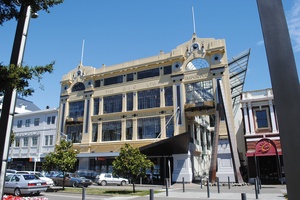
This project involved the adaptive reuse of Palmerston North’s old DIC department store as well as additions to it. Key moves included keeping retail at ground-floor level to generate income for the library, a main entry cut into the northern bay of the old façade, and a pedestrian street taking library users from both The Square and George Street up to the mezzanine level. The lively interior was given living room-sized areas for different subject areas, bold colours and exposed columns, pipes and ducts. The project earned an NZIA National Award in 1998.
03. 2001 – New Lynn Community Centre
45 Totara Avenue, New Lynn, Auckland, by Architectus
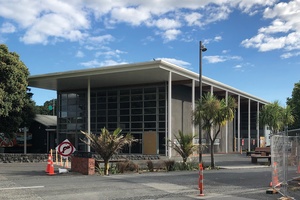
Wedged between a railway line and a busy shopping street, this multi-purpose facility includes public meeting rooms, Plunket Rooms, sports facilities and a performance hall. The building’s civic presence is greatly enhanced by its outdoor spaces – a generous colonnade and a retained heritage building define a nicely scaled public square that links to the busy street. The project received an NZIA New Zealand Award in 2002. See Architecture NZ Sept/Oct 2001. The Community Centre is currently closed for renovation but now sits within a wider town centre renewal project, which includes Moller Architects’ 2005 library and Architectus’ 2010 rail station.
04. 2002 – Māngere East Library
370 Massey Road, Māngere East, Auckland, by Jasmax
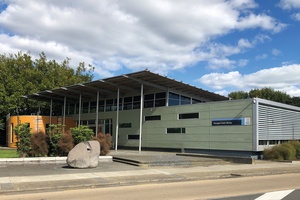
This project is most notable for the explicit way in which it drew in the aspirations and culture of its local community. John Hunt wrote, “community workshops played a key role in establishing local needs and expectations and in establishing a design direction. Familiar themes of voyage, arrival and welcome merge as part of a strategy for giving the building cultural identity and these provided a ‘storyline’ against which the more pragmatic issues of functional planning could be tested.” See Architecture NZ March/April 2004. A short drive away at 85 Church Street is the Onehunga Library by ASC Architects, built around the same time and employing a similar neomodern vocabulary.
05. 2003 – Paraparaumu Library
9 Iver Trask Place, Paraparaumu, by Warren and Mahoney

In a town long defined by a large 1970s’ shopping mall, this building was part of a plan to extend the civic zone beyond the donut of car parks that previously circumscribed urban activity. A wonderfully crisp neomodern composition, the building won an NZIA Supreme Award in 2004. However, the plan for a new civic zone hasn’t fully materialised, and the building is undermined by a peripheral location and a tight sense of enclosure. See Architecture NZ March/April 2004. Warren and Mahoney fans might also visit its Karori Community Library (2006) at 247 Karori Road in Wellington.
06. 2003 – South Christchurch Library and Service Centre
66 Colombo Street, Christchurch, by Warren and Mahoney
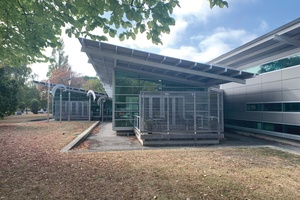
Wrapped in a refined, Glenn Murcutt-esque shell, this project includes a wide range of community amenities, but pulls all the action firmly inside the perimeter – it has a moat! It was the winner of an NZIA Supreme Award in 2004. See Architecture NZ March/April 2004. Warren and Mahoney has produced a swag of libraries around Christchurch that reward exploration: New Brighton Library (1999) at 213 Marine Parade, New Brighton; Upper Riccarton Community and School Library (2006) at 71 Main South Road, Sockburn; Lincoln Library and Service Centre (2014) at 22 Gerald Street, Lincoln; and Kaiapoi Museum and Library (2015) at 176 Williams Street, Kaiapoi.
07. 2007 – Franklin: The Centre
10 Massey Avenue, Pukekohe, by ASC Architects

Situated on the periphery of Pukekohe’s town centre, but alongside a War Memorial Hall, the project seeks to define a civic hub. The result of a design competition, the robust composition of the main volumes gives urban presence, while some well-positioned amenities create pedestrian appeal and a sense of welcome. Internally, a generous foyer allows the library to be secure while creating the feeling of transparency and free movement between the various functions – café, information centre, art gallery and the adjacent hall. It was the winner of an NZIA New Zealand Award in 2008. See Architecture NZ May/Jun 2008.
08. 2011 – Birkenhead Library and Civic Centre
206 Hinemoa Street, Birkenhead, Auckland, by Archoffice
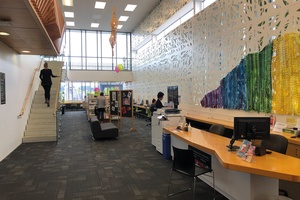
Located on a busy street and facing onto a green space, the project combines a library with an array of smaller amenities such as meeting rooms, Plunket Rooms and Citizens Advice Bureau. The jury wrote of this winner of an NZIA New Zealand award in 2011: “A bold urban strategy has created a distinctive and inviting civic building that provides a much-needed boost to the public realm in a North Shore suburb. The Birkenhead Library is both approachable, via a new corner park, and declarative, with its balcony cantilevered over the street and large-scaled, shaped timber screen.” See Architecture NZ July/Aug 2011.
09. 2012 – Whakatāne Library and Exhibition Centre
49 Kakahoroa Drive, Whakatāne, by Irving Smith Jack Architects
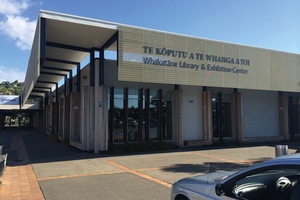
At a time when new commercial development was drawing life away from Whakatāne’s town centre, Te Kōputu a te Whanga a Toi involved the low-cost conversion of a bland but well-located big-box retail outlet into a community facility. The budget was tight but particular attention was paid to the transitional spaces – a canopy, seats and cleverly designed entry space providing attractive places for citizens to linger, supporting the revitalisation of the town centre. The project was the winner of an NZIA New Zealand Award in 2013. See Architecture NZ Jan/Feb 2013.
10. 2014 – Waiheke Library
131 Ocean View Road, Oneroa, by Pacific Environments
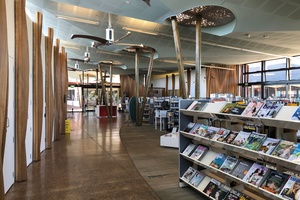
Located in a prominent position – high on a ridge line on one of Waiheke’s main roads – the project presents a dramatic frontage to the street. A wavy wall of timber louvres shields the library space, while a flying roof defines a generous porch that provides access to both the new building and a number of previously existing facilities beyond. The building is an intriguing combination of crisp lines and rough materials – machined timber louvres to the exterior, and columns made on whole tree trunks on the interior. The project received the Supreme gong at the 2015 Timber Design Awards.
11. 2013–2015 – Devonport Library
2 Victoria Road, Devonport, Auckland, by Athfield Architects
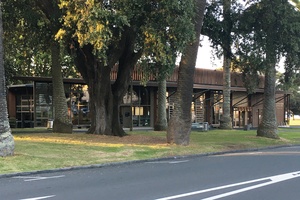
Putting new buildings in reserves is never without controversy. This one was the result of a limited competition to replace an old building, with footprint, bulk and height all pre-determined. Athfield Architects contrasted the predominant plastered brick of Devonport Village with a wooden building that spoke directly to the trees of the reserve. Timber panelling is carried through into the interior, which also enjoys natural light and ventilation. Te Pātaka Kōrero o Te Hau Kapua’s many awards included an NZIA Local award for public architecture. Athfield Architects also designed alterations to Auckland Central City Library in 2016.
12. 2018 – Tūranga
60 Cathedral Square, Christchurch, by Architectus and Schmidt Hammer Lassen
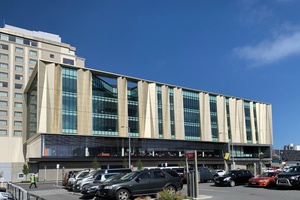
Positioned on a key edge of Cathedral Square, this project sought to inject life into a particularly badly quake-damaged quadrant of the city. Designed in collaboration by Architectus and Danish firm Schmidt Hammer Lassen with Matapopore Trust and Ngāi Tūāhuriri, the project was intended as a flagship for the city’s library services, and it shows. It’s chocka with public meeting spaces, artwork, mana whenua narratives and viewing terraces, all arranged around a dramatic full-height atrium. This is what community architecture looks like when it’s fully resourced and allowed to draw in the full range of inputs and expertise. Much loved by locals, the project won the 2019 NZIA John Scott Award for Public Architecture. See Architecture NZ Jan/Feb 2019.
13. 2019 – Hihiaua Cultural Centre
56–58 Herekino Street, Whangārei, by Moller Architects

Hybridising the whare with Western building types has been a key thread in post-WWII Kiwi architecture – it gave us some of our most interesting houses, churches and public buildings. The first stage in a larger project, Hihiaua is explained as part whare and part industrial shed. This allows fairly heavy-duty fabrication – particularly the carving of waka – to be combined with handcrafts, and educational and social activities. A generous porch provides both civic scale and social amenity. It’s a triumph of more-with-less. The building was the winner of the NZIA John Scott Award for Public Architecture in 2020. See Architecture NZ Nov/Dec 2020.
14. 2021 – Te Matapihi Bulls Community Centre
4 Criterion Street, Bulls, by Architecture Workshop
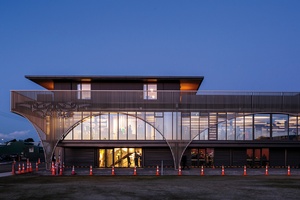
Located on the main street of a small and fairly sleepy town, this project gathers all the town’s civic facilities: town hall, information centre, meeting rooms, library, bus stop and new town square. A slatted screen wraps the building, both imbuing a civic scale and defining useful covered spaces. For a small community, a project of this scale and complexity is hard to achieve but the amenity provided and interaction supported is likely to prove profoundly valuable. Architecture Workshop enthusiasts finding themselves in Canterbury should visit its 2019 Lakeside Soldiers Memorial Hall, Harts Road, Leeston. See Architecture NZ Sept/Oct 2019.
Other addresses
Northcote Library (1982) – Ernie Mays Street, Northcote, Auckland, by Hill Manning Mitchell. The huge walls of glass on the façade and the exposed trusses on the interior are crisply detailed and softened by romantic elements, particularly the coloured windows and vine-covered trellised walkway. See NZ Architect no. 3, 1982.
East Coast Bays Library (1982) – 8 Bute Road, Browns Bay, Auckland, by Dodd Patterson Architects. Something of an under-the-radar gem, the building exterior is almost domestically scaled. Within is a lovely series of spaces designed around a solar energy system centred on a trombe wall. See New Zealand Home & Building no. 1, 1983.
Oranga Community Centre (2003) – 52 Waitangi Road, Oranga, Auckland, by RTA Studio.
Te Atatū Peninsula Library and Community Centre (2014) – 595 Te Atatū Road, Te Atatū Peninsula, by Moller Architects. See Architecture NZ Jul/Aug 2015.
Rānui Library (2015) – Cnr Swanson Road and Armada Drive, Rānui, by Jasmax.
HB Williams Memorial Library Extension (2018) – 34 Bright Street, Gisborne, by Chow:Hill. An extension of an iconic building by local firm Glengarry, Corson & Pilbrow in association with E. W. Armstrong, originally completed in 1967.
Waitohi Johnsonville Library and Community Hub (2019) – 34 Moorefield Road, Johnsonville, Wellington, by Athfield Architects. See Architecture NZ May/June 2020.
The itinerary series is supported by Dulux Colours of New Zealand. Dulux Colour Specialist Davina Harper has selected a Colours of New Zealand palette based on this itinerary. See the full range and order colour samples here.

Sources
Nikolaus Pevsner’s A History of Building Types (London: Thames & Hudson, 1976) includes a rather good chapter on the evolution of libraries up to the 1970s. Barnaby Bennett penned a great essay that looks at the role of libraries in contemporary New Zealand public life, published in Public Knowledge (Christchurch: Freerange Press, 2020).
These projects were widely published in the journals of their respective days. A collection of articles published in Architecture NZ March/April 2004 covered the state-of-the-art at that particular time.
Many of the firms included above have published monographs – see Amanda Hyde de Kretser (ed.), Architectus: Bowes Clifford Thomson (Auckland: New Zealand Architectural Publications Trust, 2004), New Territory: Warren and Mahoney (Auckland: Balasoglou Books, 2005), Stephen Stratford (ed.), Jasmax (Auckland: New Zealand Architectural Publications Trust, 2007) and Julia Gatley, Athfield Architects (Auckland: Auckland University Press, 2012).
For earlier work, take a look at our key general architectural histories, including: Peter Shaw’s New Zealand Architecture (Auckland: Hodder & Stoughton, 1991) and Terence Hodgson’s Looking at the Architecture of New Zealand (Grantham House Publishing, Wellington, 1990).









